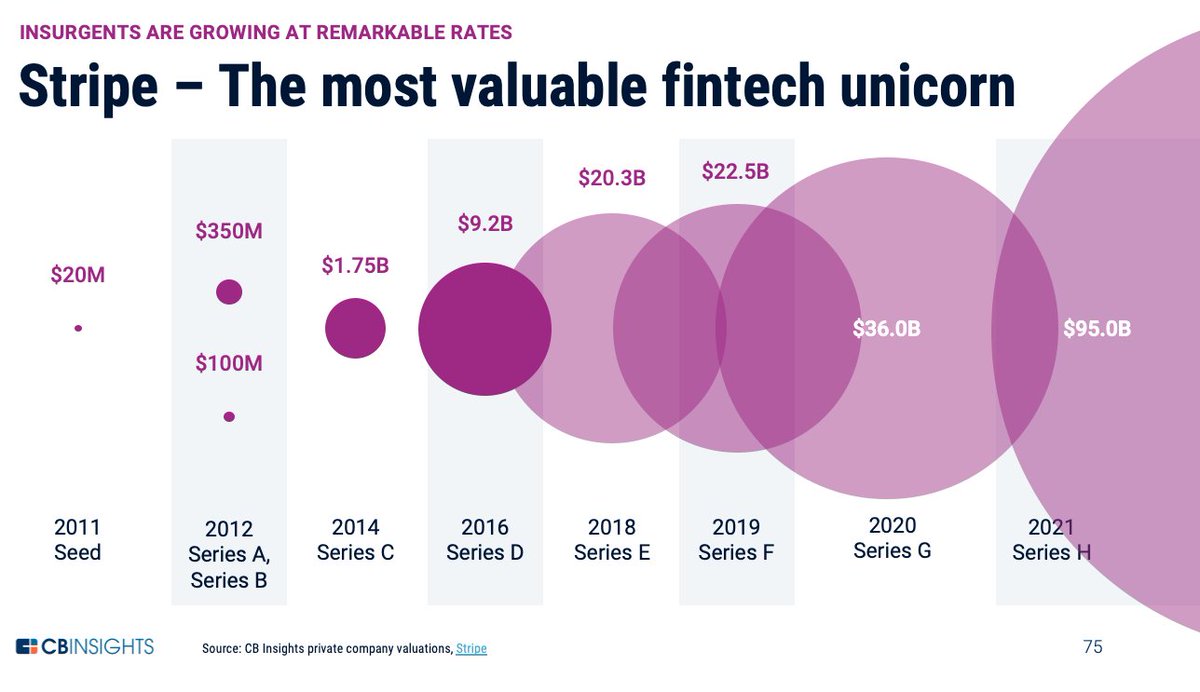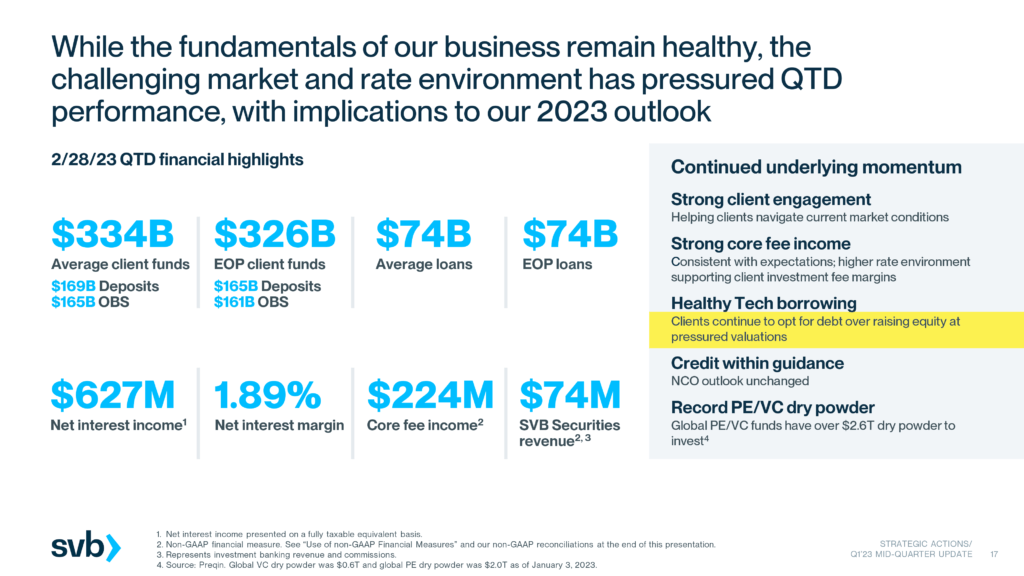Q: How have the valuations of the largest financial services firms fared over the last 3 years?
A: Not great (data below)
We're seeing a dramatic changing of the guard in financial services
It was happening gradually
Now, it's happening suddenly
Here's why
A: Not great (data below)
We're seeing a dramatic changing of the guard in financial services
It was happening gradually
Now, it's happening suddenly
Here's why
https://twitter.com/asanwal/status/1413171509565263872
2/ First, a framework to evaluate this through courtesy of Ernest Hemingway in The Sun Also Rises where he asks
"How did you go bankrupt?"
"How did you go bankrupt?"

3/ The answer
"To ways...Gradually and then suddenly"
This is the creative destruction we're seeing in financial services right now
"To ways...Gradually and then suddenly"
This is the creative destruction we're seeing in financial services right now

4/ We all know software is eating the world
It's been happening for a while
But here's the data
In 2006, 1 of the 5 most valuable cos was a tech co
In 2011, it was still 1
In 2016, tech ran the table
It's been happening for a while
But here's the data
In 2006, 1 of the 5 most valuable cos was a tech co
In 2011, it was still 1
In 2016, tech ran the table
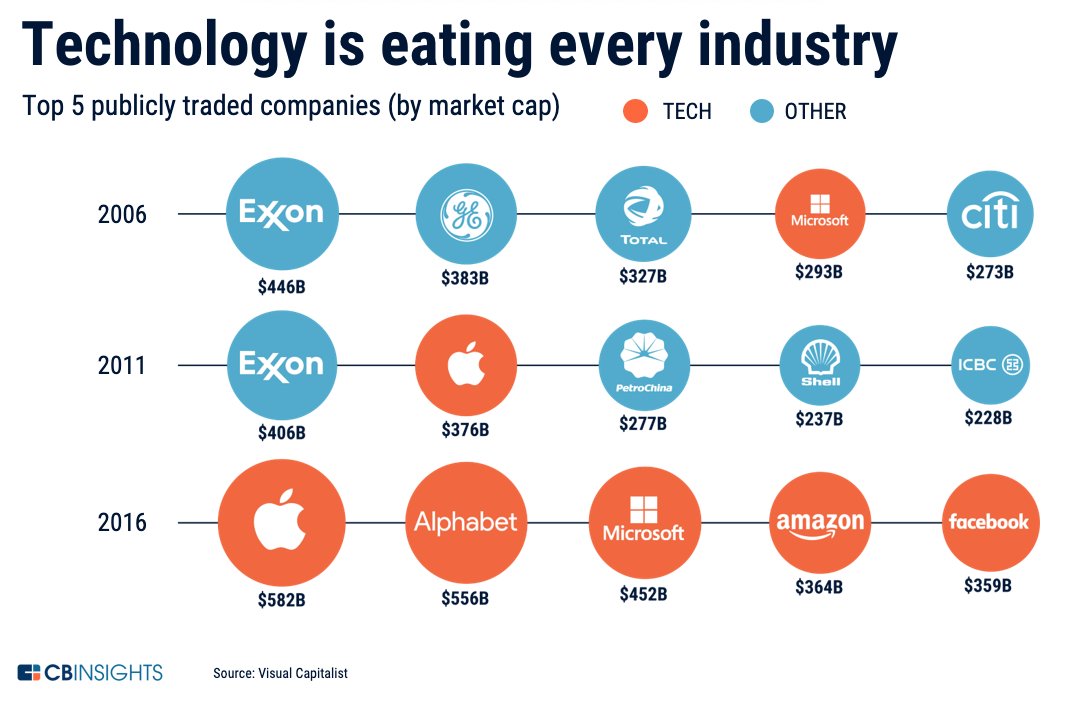
5/ What's even wilder is the picture in 2021
Tech just keeps winning
Oil & gas, financial services, etc are nowhere to be found
Tech just keeps winning
Oil & gas, financial services, etc are nowhere to be found
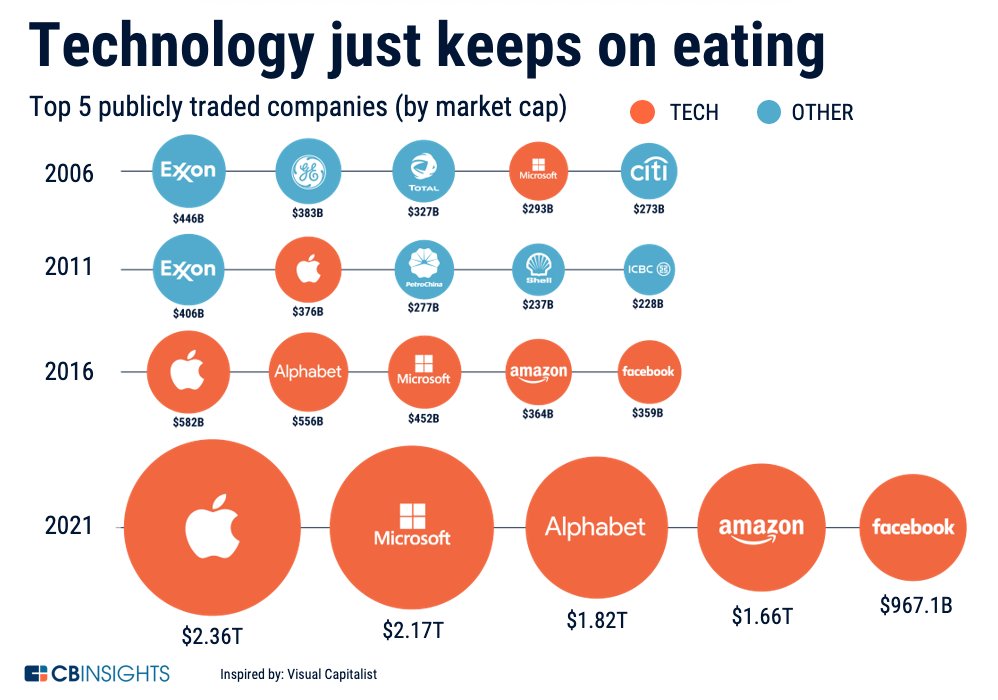
6/ Financial services firms saw this and started talking about becoming more technology forward
This is from my @CBinsights Future of Fintech keynote in 2018
This is from my @CBinsights Future of Fintech keynote in 2018

7/ In 2018, they started to see their competitive set be redrawn
I used to work at American Express and when I was there, we talked about our competitors being Citi, Visa, Mastercard, Cap One, etc
Now it's Paypal, Stripe, Affirm, etc
I used to work at American Express and when I was there, we talked about our competitors being Citi, Visa, Mastercard, Cap One, etc
Now it's Paypal, Stripe, Affirm, etc

8/ But in 2018, when I talked about Gradually Then Suddenly coming to financial services, it felt like we were still in the "gradually" part
What does that look like?
Here's an example. See if you can name the company (it's not from financial services)
Stock chart below
What does that look like?
Here's an example. See if you can name the company (it's not from financial services)
Stock chart below

11/ That company was Blackberry / Research in Motion
Look at these headlines right before the sudden fall
Look at these headlines right before the sudden fall

12/ But you'll argue that financial services firms are different
It's highly regulated, they have moats, they have massive balance sheets, they have brands, etc
True but that's not enough
Suddenly is here for financial services
Why? 2 reasons
It's highly regulated, they have moats, they have massive balance sheets, they have brands, etc
True but that's not enough
Suddenly is here for financial services
Why? 2 reasons
13/ Those 2 reasons:
1. An absolute flood of fintech innovation capital
2. The great financial services unbundling
Let's unpack those a bit
1. An absolute flood of fintech innovation capital
2. The great financial services unbundling
Let's unpack those a bit

14/ Before I get into why this capital is so important, it's worth paring this with the fact that it's become cheaper to create a startup
AWS, Azure, No-code, Low-code, etc have made the building part cheaper
That means more insurgents can start up
AWS, Azure, No-code, Low-code, etc have made the building part cheaper
That means more insurgents can start up

15/ Fintech startups have APIs, embedded finance, BaaS, open banking protocols, etc as well
But they have an absolute deluge of capital coming their way
In Q2'21, $1 of every $5 venture dollars went to fintech ($33.7B)
But they have an absolute deluge of capital coming their way
In Q2'21, $1 of every $5 venture dollars went to fintech ($33.7B)
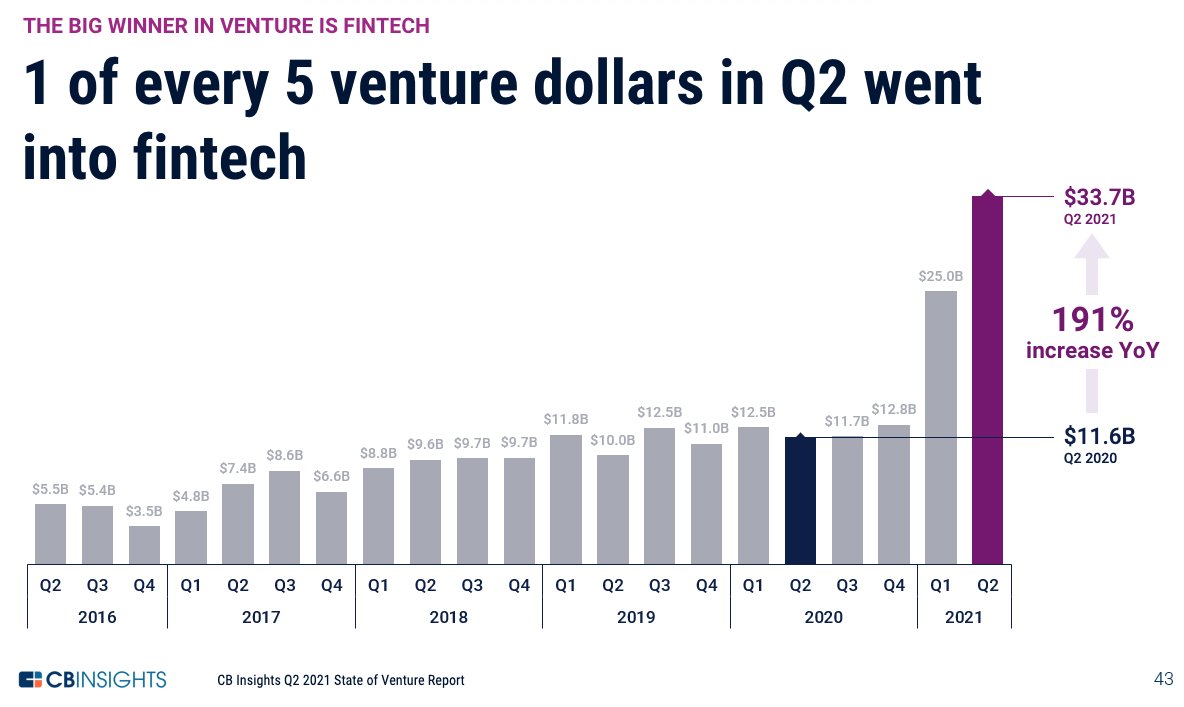
16/ This capital is also coming from the smartest investors out there a la @sequoia @Accel @a16z @IndexVentures @RibbitCapital 

19/ So we have smart founders paired with smart investors tackling a giant market
Add in recent successful fintech exits which ultimately serve to spur more financing
The venture "circle of life"
Add in recent successful fintech exits which ultimately serve to spur more financing
The venture "circle of life"

20/ So a ton of smart innovation capital is flowing into fintech
The 2nd force is unbundling of financial services
When legacy FS companies think about markets, they only get excited by giant markets
We can call this the "curse of the TAM"
The 2nd force is unbundling of financial services
When legacy FS companies think about markets, they only get excited by giant markets
We can call this the "curse of the TAM"
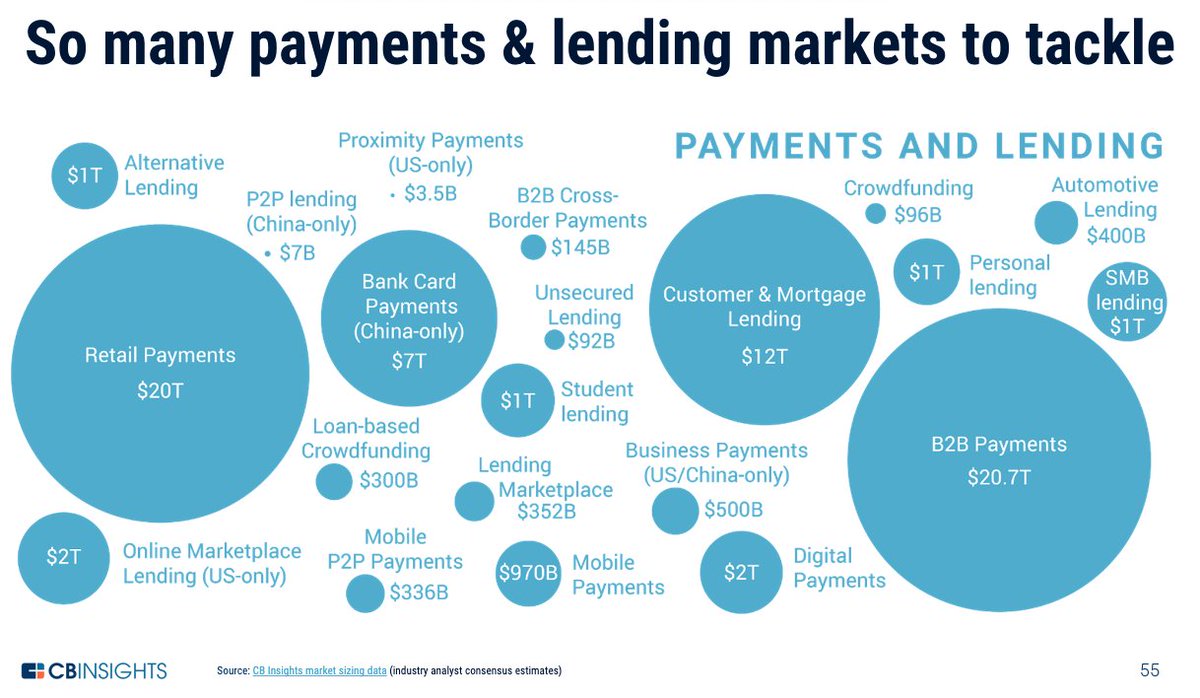
21/ Bastardizing Jeff Bezos quote on margins, we find legacy banks, payment firms, insurers, etc obsess on TAM
And thus leave openings for startups who are unafraid to 'niche down' to build a beachhead in a market
And thus leave openings for startups who are unafraid to 'niche down' to build a beachhead in a market

22/ Here are examples of what most legacy FS folks might argue are small TAM markets that startups are willing to tackle and building valuable franchises in
"Teen-focused challenger banks"
"Teen-focused challenger banks"

23/ BNPL comes to every service, product imaginable
You think a large legacy financial services firm is going to tackle BNPL for weddings or auto dealers?
Hell no
Ain't no TAM in that
You think a large legacy financial services firm is going to tackle BNPL for weddings or auto dealers?
Hell no
Ain't no TAM in that
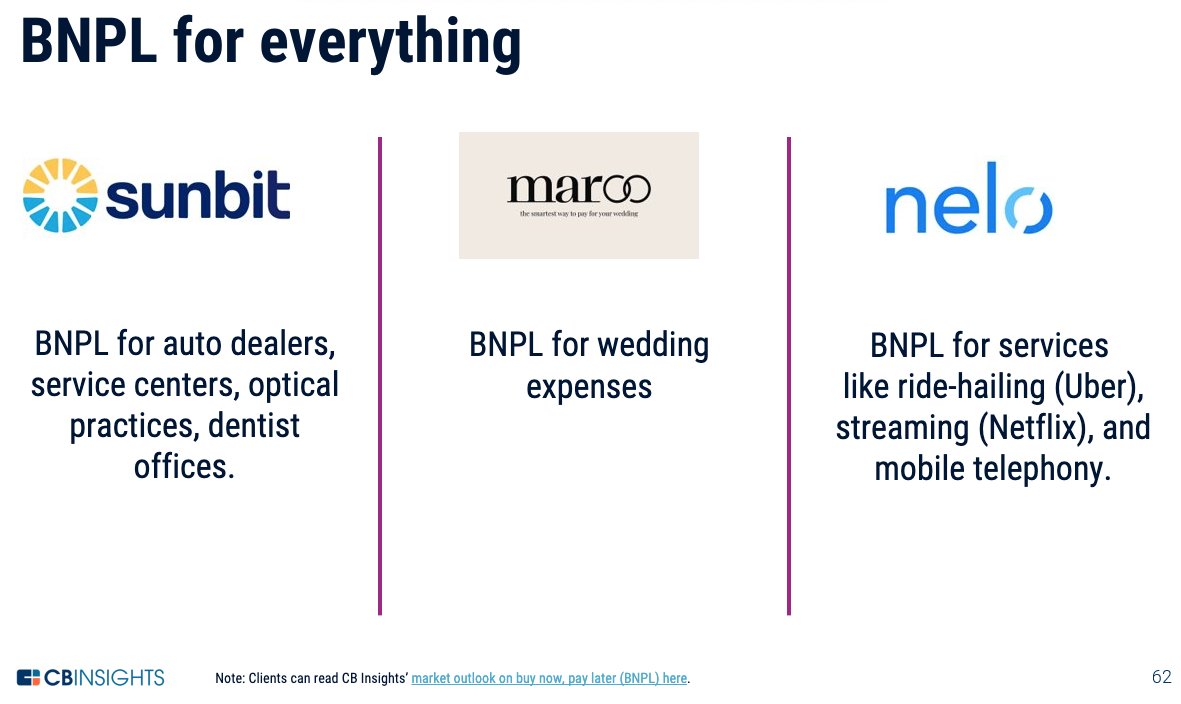
24/ How about giving access to an asset class like supply chain financing or sports memorabilia or startups?
No legacy FS firm is going to put resources ($$, their best people, etc) on this
And these are where startups build credibility and grow from
No legacy FS firm is going to put resources ($$, their best people, etc) on this
And these are where startups build credibility and grow from

25/ Imagine being at a big bank or payments co and pitching
"We should build an app to help divorced parents manage shared expenses"
or
"Let's focus on unbanked workers, mostly 1st and 2nd immigrants"
These are not the types of ideas you bring if you want to move up
"We should build an app to help divorced parents manage shared expenses"
or
"Let's focus on unbanked workers, mostly 1st and 2nd immigrants"
These are not the types of ideas you bring if you want to move up

26/ I'm not saying all these cos are great ideas / will succeed
But a handful of them will make it and start doing other things
Look @stripe's relationships which suggest their moves into BNPL, banking, b2b payments, etc
Product "land & expand"
But a handful of them will make it and start doing other things
Look @stripe's relationships which suggest their moves into BNPL, banking, b2b payments, etc
Product "land & expand"

27/ So lots of capital + great unbundling means these startups can and will grow quickly
Now let's go back and look at the most valuable financial services firms from 2018
Now let's go back and look at the most valuable financial services firms from 2018

28/ Since then, 9 of 14 have actually seen market cap declines
This is against the backdrop of a crazy bull market
This is against the backdrop of a crazy bull market

29/ Now, let's look at the valuation climbs of some of the insurgent fintech companies
Quotes are by media outlets / pundits over time :)
Quotes are by media outlets / pundits over time :)

33/ Can't do animations on Twitter so bear w/ me on this one
x-axis is age of co
y-axis is valuation
The OGs in FS are 60-200+ years old (the dots on the right)
On the left is the new guard
They're not as big (yet) but they've created massive value in a fraction of time
x-axis is age of co
y-axis is valuation
The OGs in FS are 60-200+ years old (the dots on the right)
On the left is the new guard
They're not as big (yet) but they've created massive value in a fraction of time

34/ I was reminded of this great graphic on technology adoption over time
The telephone took 105 years to reach 90% of US households
While the internet & cellphone did it in 15 years
Something similar is occurring in financial services
The telephone took 105 years to reach 90% of US households
While the internet & cellphone did it in 15 years
Something similar is occurring in financial services

35/ The level of creative destruction coming to financial services is massive and it is now coming not gradually, but suddenly
Last thought
Or actually a question
All the fintech unicorns at present are worth ~1 JP Morgan Chase
Who would you buy?
Last thought
Or actually a question
All the fintech unicorns at present are worth ~1 JP Morgan Chase
Who would you buy?

36/ Want the full "Gradually, then Suddenly: The Sequel" presentation?
Lots of good data and dataviz on financial services and why incumbent FS firms better get their isht together
Grab it here -- cbinsights.com/research/repor…
It's free
Lots of good data and dataviz on financial services and why incumbent FS firms better get their isht together
Grab it here -- cbinsights.com/research/repor…
It's free

37/ Fresh out of the oven
Q3'21 Fintech data is now out, and it was a killer quarter
Funding up 96% vs 2020 and we're only 3 quarters in
Fintech is still en fuego 🔥
cbinsights.com/research/repor…
Q3'21 Fintech data is now out, and it was a killer quarter
Funding up 96% vs 2020 and we're only 3 quarters in
Fintech is still en fuego 🔥
cbinsights.com/research/repor…
• • •
Missing some Tweet in this thread? You can try to
force a refresh







